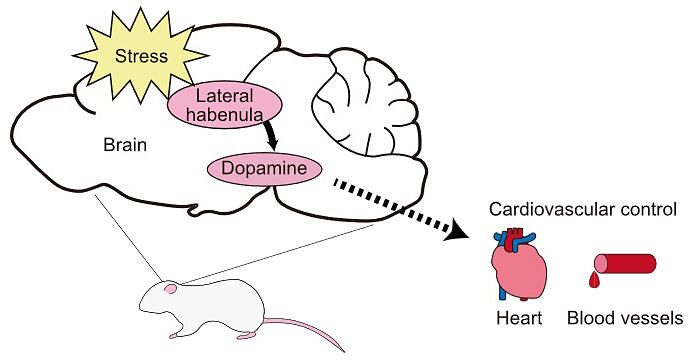Associate Professor Tadachika Koganezawa and Graduate Student Yuma Sato of the Institute of Medicine at the University of Tsukuba have announced that their research group has elucidated the neural mechanism of stress-related cardiovascular responses. They investigated the neuronal mechanism by which the cardiovascular responses were induced in experiments using rats, with a focus on the lateral habenula, a brain region with neurons that are activated by stress stimulation. The results showed that the elicitation of cardiovascular responses by activation of the lateral habenula was mediated by the dopaminergic nervous system, in particular, the dopamine-releasing neurons (dopaminergic neurons) in the ventral tegmental area. The findings are expected to contribute to the development of prophylactic and therapeutic approaches to autonomic imbalance and cardiovascular diseases that are associated with stress-induced psychiatric disorders. The results were published in the international journal Frontiers in Physiology on November 21.

Excitation of the lateral habenula alters blood pressure and heart rate. This change in blood circulation response was mediated by the dopaminergic system (the neurons of the ventral tegmental area).
Provided by the University of Tsukuba
When organisms are exposed to mental stress, they undergo behavioral changes to adapt to it, such as freezing and fight-or-flight responses. These behavioral responses induce various physiological responses in the body, including changes in blood pressure.
The center of cardiovascular regulation is located in the medulla oblongata in the brain, and this cardiovascular center maintains homeostasis by regulating the functions of the heart and blood vessels via the autonomic nervous system. The cardiovascular center in the medulla oblongata is controlled by neurons from many other brain regions. Under stress, brain regions responding to stress externally alter the activity of the cardiovascular center in the medulla oblongata, contributing to appropriate cardiovascular regulation, but the detailed mechanisms were unknown.
In this study, the research group focused on the lateral habenula, which is a brain region related to stress coping, and a system controlled by the lateral habenula via the dopaminergic nervous system. They aimed to elucidate the neural mechanisms of the cardiovascular responses induced by the excitation of the lateral habenula. Electrical excitation of the lateral habenula in anesthetized rats increased blood pressure and decreased heart rate during stimulation. Meanwhile, when the blockade of receptors for the neurotransmitter dopamine suppressed the cardiovascular responses induced by stimulation of the lateral habenula, only weak changes in blood pressure and heart rate were observed even with a comparable level of electrical stimulation.
Moreover, pharmacological inactivation of the ventral tegmental area, which is controlled by neurons from the lateral habenula, suppressed the blood pressure increase and heart rate decrease induced by excitation of the lateral habenula. The ventral tegmental area is controlled by neurons from the lateral habenula and has many dopaminergic neurons.
These results indicate that the cardiovascular responses induced by excitation of the lateral habenula under stress are mediated particularly by the ventral tegmental area of the dopaminergic system.
Koganezawa said, "This study has provided important insights into how the brain regulates blood flow as an adaptation strategy under mental stress. Moving forward, this finding is expected to contribute to the elucidation of the mechanisms of and the development of new therapies for mental stress-induced cardiovascular diseases such as hypertension."
Journal Information
Publication: Frontiers in Physiology
Title: The dopaminergic system mediates the lateral habenula-induced autonomic cardiovascular responses
DOI: 10.3389/fphys.2024.1496726
This article has been translated by JST with permission from The Science News Ltd. (https://sci-news.co.jp/). Unauthorized reproduction of the article and photographs is prohibited.




